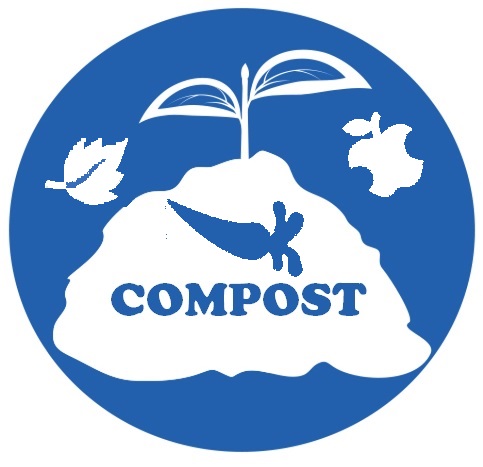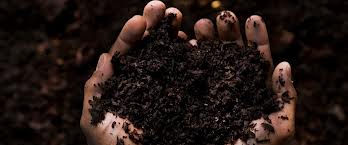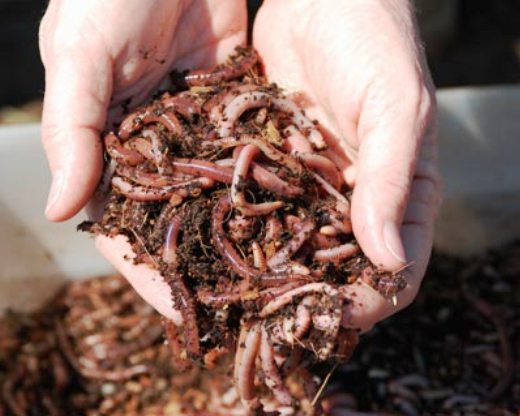Make Soil Not Garbage
On July 1, 1990, landscape waste was banned from Illinois landfills. No such ban exists for food scraps (also known as organic waste). Natuarlly, one of the biggest sources of organic waste comes from our kitchens, in the form of peelings and undesirable food remains, often placed in the trash and transported to our area landfills. Kitchen and landscape waste can be turned into valuable soil through the process of composting.
Compost is the result of the activity of numerous tiny organisms that need two main compounds for their life processes – carbon for energy and nitrogen for growth and reproduction. As the differing organisms go through the organic materials, the byproducts undergo decomposition and eventually most of the digestible material is consumed and transformed, leaving behind a rich soil amendment.
Composting allows us to recycle organic waste to produce fertilizer for shrubs, flowers, and vegetables in our gardens. It can be used as mulch, or made into "tea." It improves soil by adding nutrients and improving its ability to hold water.
Before you start:
- Check with your village, city, or township office to see if any composting rules exist for your location.
- Choose a level area in your yard that has good drainage.
- Be considerate of neighbors and keep your compost site away from property lines.
If you create a pile with no enclosure, your dimensions should be at least 3’ X 3’ X 3’. Or, build a compost structure using a variety of materials (treated wood, chicken wire, cinder block, etc.). There are a number of commercial containers available. You can be an aggressive or passive "composter." The more attention you give your pile and its contents, the faster it will yield rich dark compost.
Check out these websites for various styles and instructions:

The Do's Of Composting
The four main ingredients for successful composting are: moisture (water or fresh greens), oxygen (turn your pile), nitrogen (greens), and carbon (browns). An equal amount (1 to 1 ratio) of greens and browns is a great place to start. Don’t be nervous about exact measurements or getting your compost mixture perfect. Remember, all things organic will break down over time.
GREENS (G) = Nitrogen BROWNS (B) = Carbon
| B |
Cardboard rolls |
| B |
Clean paper |
| G |
Coffee grounds and filters |
| B |
Dryer and vacuum cleaner lint |
| G |
Eggshells
|
| G |
Flowers |
| G |
Fruits and vegetables (uncooked) |
| G |
Grass clippings |
| G |
Hair and fur |
| B |
Hay and straw |
| G |
Houseplants |
| B |
Brown leaves |
| G |
Livestock manure |
| B |
Nut shells |
| B |
Sawdust |
| B |
Shredded cardboard |
| G |
Tea bags |
| B |
Wood chips |
| G |
Yard trimmings |
If your pile gets too wet or has an odor, add more browns. If your pile is too dry or seems inactive, add more greens and some water. Turn or mix the pile weekly to bring in oxygen and jump start decomposition. Your compost can be ready to use in as little as two weeks or take up to twelve months. In general, compost is ready when it's dark and crumbly, mostly broken down with a pleasant, earthy, soil-like smell.
The Don'ts of Composting
- Black walnut tree leaves or twigs release substances that might be harmful to plants.
- Coal or charcoal ash might contain substances harmful to plants.
- Dairy products (e.g., butter, egg yolks, milk, sour cream, yogurt) create odor problems and attract pests such as rodents and flies.
- Diseased or insect-ridden plants may transfer the diseases or insects back to other plants.
- Fats, grease, lard, or oils create odor problems and attract pests such as rodents and flies
- Meat or fish bones and scraps create odor problems and attract pests such as rodents and flies.
- Pet wastes (e.g., dog or cat feces, soiled cat litter) might contain parasites, bacteria, germs, pathogens, and viruses harmful to humans.
- Yard trimmings treated with chemical pesticides might kill beneficial composting organisms.
Limited Yard Space? Compost Indoors with Vermicomposting!

If you have room under the kitchen sink or in the garage or basement you can compost indoors.
What You'll Need...
Look for a plastic or untreated wood container, roughly the size of a small aquarium. The worm bin can be around 3-8" deep. Surface size is very important! You need approximately 1 square foot of surface area per person in your household. A container with a lid can help keep the bin from drying out; however, you must puncture or drill holes in the lid to ensure air flow. Some people find that old window screens work well too. Create moist (consistency of a wrung out sponge) bedding for the worms by adding damp Coir (compressed coconut husk fibers, available at garden stores or on-line) to the container. Add a bit of sand and soil to help the worms digest the food in their gizzards. Purchase red wiggler worms from a local bait shop or online. If you start with a pound of worms, they will eat approximately 1/2 pound of food each day. Bury your fruit and vegetable scraps in the bedding. When the bedding is moist and black, harvest the worm castings, and start again.
Top 10 Facts About Red Wiggler Worms
- Eat twice their weight each day
- Have no teeth or eyes
- Have a gizzard to help digest their food
- Have 5 sets of hearts
- Are neither male or female (hermaphrodite)
- Won’t regenerate if they are cut in half
- Will die in very hot or cold weather
- Will lay cocoons in the soil
- Will not digest plastics, metals, or glass
- Can remove toxic pollution found in soil
Check out these websites for information on vermi-compost bins:
Landscape Waste
Grass Cycling
Cut it high and let it lie! To save time and reduce the amount of waste that is collected and processed, the Environmental Protection Agency recommends leaving grass clippings on your lawn. Grass clippings increase the soil's organic matter, along with its ability to retain moisture and nutrients, resist erosion, and maintain cooler temperatures during the summer. Clippings should be no more than one inch long in order to fall through the grass into the soil.
Laws Prohibit Burning
Many municipalities have "no burning ordinances." The reasons for such strong opposition to burning are based on the detrimental effects of burning landscape waste, which are:
- Reduces visibility and creates road and safety hazards. The smoke and smell from burning also create a nuisance to neighbors
- Creates fire hazards and can destroy property when out of control. Is the cause of most of the wildfires caused by people, placing additional demands on local police and fire departments.
- Pollutes the environment when smoke particles fall into our water and on our soil. Microscopic particles from burning are present even when the air may not appear smoky.
- Contributes to health problems by emitting smoke containing a complex mixture of fine particles, carbon monoxide, hydrocarbons, and other toxic substances with known adverse health effects. Breathing particulate matter can increase the chances of respiratory infection, reduce the volume of air inhaled and impair the lungs' ability to use that air.
- Contact the Illinois Department of Public Health, the American Lung Association, or the U.S. EPA for more information.
Click Here to download PDF Composting Brochure